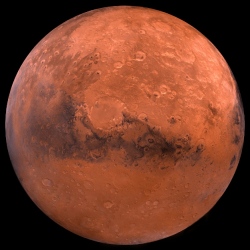
Scientists have located an impact crater linked to tsunamis that swept across part of ancient Mars. The team believe an asteroid triggered 150m-high waves when it plunged into an ocean thought to have existed on northern Mars three billion years ago. Lomonosov crater in the planet’s northern plains fits the bill as the source of tsunami deposits identified on the surface.
Although the idea has lost some of its currency in recent years, some scientists think an ocean might once have filled the vast lowland region that occupies the Red Planet’s northerly latitudes.
Growing evidence that tsunami waves washed over the boundary between the southern highlands and northern lowlands help strengthen the hypothesis.
François Costard, Steve Clifford and colleagues identified and mapped the distribution of sediment that apparently originated in the northern plains and flowed onto a possible ancient shoreline to the south.
"We found typical tsunami deposits along the dichotomy between the northern hemisphere and southern hemisphere of Mars," Dr Costard, from Université Paris-Sud and CNRS, told BBC News.
"It supports that there was, at that time, a northern ocean."
One type of feature seen on the dichotomy boundary is a lobate flow deposit. Dr Clifford, from the Lunar and Planetary Institute in Houston, explained the evidence.
"These lobate deposits propagate uphill from the northern plains and do so in close association with a potential palaeo-shoreline. The predictions of the numerical modelling that François and his colleagues have done provide a very persuasive case for an ocean at this time," he told BBC News.
"There’s also a second set of landforms that we see along the coastline called thumbprint terrain…. the reflection of the tsunami waves from the coast and their interaction with a second set of tsunami waves, predicted by the numerical modelling, would have resulted in sediment deposition that’s very similar to what we actually observe on Mars."
This terrain has previously been interpreted as having been caused by mud flows, mud volcanoes, or glaciers.
The proposed Martian tsunami travelled 150km (95 miles) inland, climbing to elevations of about 100m (330ft).
"If we do have this evidence of a tsunami having occurred back three billion years ago, there must have been an ocean present in the northern plains," said Steve Clifford.
"That’s the key point here, it indicates that there was a substantial amount of water in residence on the Martian surface at this time and that has likely implications for the total inventory of water on Mars."
